#Melotte 15
Text
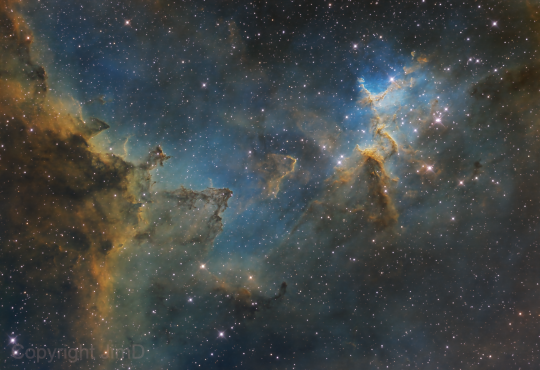
The inside of the Heart Nebula, IC 1805 // JimD
#astronomy#astrophotography#nebula#emission nebula#star-forming region#heart nebula#IC 1805#melotte 15#Sh2-190#cassiopeia
111 notes
·
View notes
Text
Viel Nebula and Melotte 15 starless


2 notes
·
View notes
Text
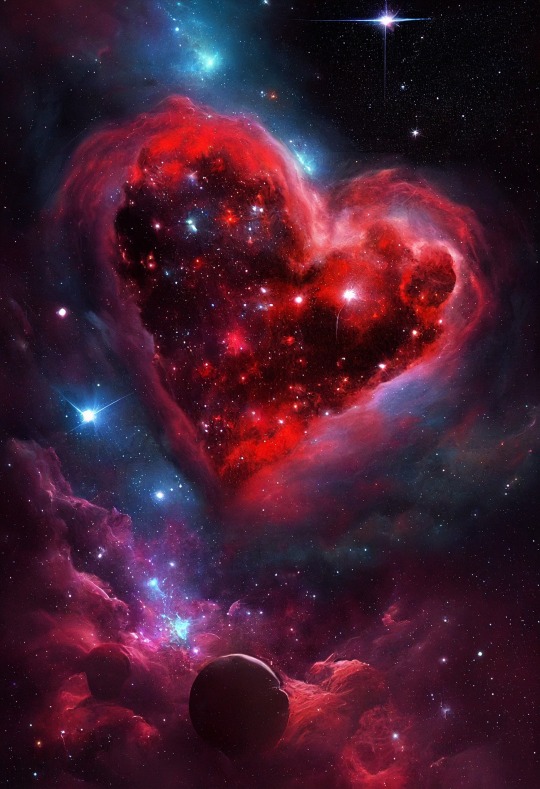
The Heart Nebula
Talon Abraxas
The Heart Nebula is an emission nebula located in the constellation of Cassiopeia, around 7,500 light years away from Earth. It has an apparent magnitude of 18.3 and an absolute magnitude of 6.5. Sometimes, it is known as the Running Dog Nebula because, when seen through a telescope, it looks a bit like a running dog.
The nebula was given its name the Heart Nebula because of its intensely red glowing gas and dark dust lanes that form a shape that resembles a heart symbol. It forms a famous complex known as the Heart and Soul with its smaller neighbour Westerhout 5, also known as the Soul Nebula, which lies just 2.5 degrees to the southeast.
The Heart Nebula is around 150 arcminutes in size and has been given the designation of Sharpless 2-190 in the Sharpless Catalogue, as well as IC 1805. The brightest part of the Heart Nebula has the designation NGC 896 in the New General Catalogue. It is classified separately because it was the first part of IC 1805 to be discovered.
The glow of the nebula comes from the radiation of a small open cluster of stars known as Melotte 15. The cluster contains very young, blue, hot supergiant stars that are about 1.5 million years old and is located near the nebula’s centre.
276 notes
·
View notes
Photo

In the Heart of the Heart Nebula : What excites the Heart Nebula? First, the large emission nebula dubbed IC 1805 looks, in whole, like a human heart. Its shape perhaps fitting of the Valentine's Day, this heart glows brightly in red light emitted by its most prominent element: excited hydrogen. The red glow and the larger shape are all created by a small group of stars near the nebula's center. In the heart of the Heart Nebula are young stars from the open star cluster Melotte 15 that are eroding away several picturesque dust pillars with their energetic light and winds. The open cluster of stars contains a few bright stars nearly 50 times the mass of our Sun, many dim stars only a fraction of the mass of our Sun, and an absent microquasar that was expelled millions of years ago. The Heart Nebula is located about 7,500 light years away toward the constellation of the mythological Queen of Aethiopia (Cassiopeia). via NASA
1K notes
·
View notes
Photo
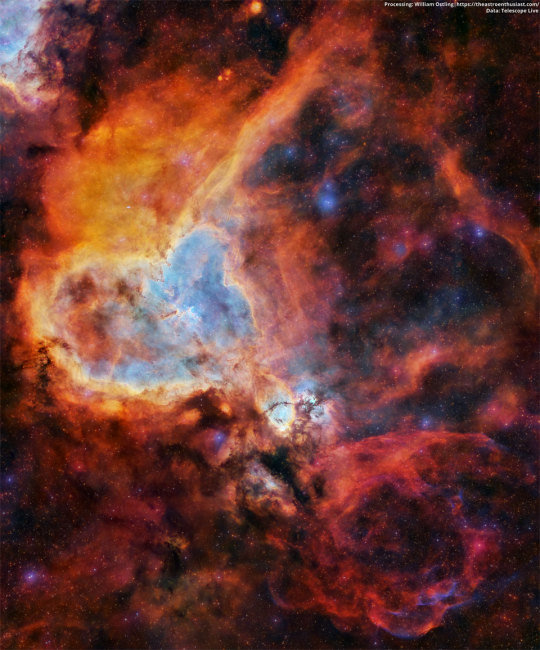
2023 December 13
Deep Field: The Heart Nebula
Image Credit & Copyright: William Ostling, Telescope Live
Explanation: What excites the Heart Nebula? First, the large emission nebula on the left, catalogued as IC 1805, looks somewhat like a human heart. The nebula glows brightly in red light emitted by its most prominent element, hydrogen, but this long-exposure image was also blended with light emitted by silicon (yellow) and oxygen (blue). In the center of the Heart Nebula are young stars from the open star cluster Melotte 15 that are eroding away several picturesque dust pillars with their atom-exciting energetic light and winds. The Heart Nebula is located about 7,500 light years away toward the constellation of Cassiopeia. At the bottom right of the Heart Nebula is the companion Fishhead Nebula. This wide and deep image clearly shows, though, that glowing gas surrounds the Heart Nebula in all directions.
∞ Source: apod.nasa.gov/apod/ap231213.html
153 notes
·
View notes
Text

SPACEMAS DAY 13 ✨🪐🌎☄️☀️🌕
The large emission nebula on the left of the image is catalogued as IC 1805 and looks somewhat like a human heart. The nebula glows brightly in red light emitted by its most prominent element, hydrogen, but this long-exposure image was also blended with light emitted by silicon (yellow) and oxygen (blue). In the center of the Heart Nebula are young stars from the open star cluster Melotte 15 that are eroding away several picturesque dust pillars with their energetic light and winds. The Heart Nebula is located about 7,500 light years away toward the constellation of Cassiopeia. At the bottom right of the Heart Nebula is the Fishhead Nebula.
Image Credit & Copyright: William Ostling, Telescope Live
#astronomy#space#science#universe#spacemas#day 13#nebula#heart#heart nebula#cassiopeia#constellation#star cluster#fish head nebula#emission nebula#hydrogen#light year#open star cluster#follow#like#reblog#the first star#the first starr#thefirststar#thefirststarr#nasa#apod#tumblr#blog#space blog#space tumblr
70 notes
·
View notes
Text

In the Heart of the Heart Nebula
“You’ll be given love. You’ll be taken care of. You have to trust it. Maybe not from the sources you have poured yours. Maybe not from the directions you are staring at. Twist your head around. It’s all around you. All is full of love.”
The Heart Nebula, or IC 1805, is a beautiful emission nebula located 7,500 light-years away in the constellation Cassiopeia. Discovered by William Herschel in 1787, it's characterized by glowing ionized hydrogen and dark molecular dust. The nebula's distinctive red color and dramatic shape are due to radiation from the nearby star cluster Melotte 15, which contains stars about 50 times brighter than our sun. A
Heart for Valentina
--Mahaboka
34 notes
·
View notes
Text

The Heart Nebula on the right (IC 1805, Sharpless 2-190) and Soul Nebula, left, (Westerhout 5 with the star cluster IC 1848) in Hydrogen-alpha. These two make up a massive star-forming complex in Cassiopeia about 7500 lightyears away in the Perseus Arm of our Galaxy. The bright emission nebula on the far right is the Fishhead Nebula (NGC 896, IC 1795). The small circular cloud, middle top, is another emission nebula Sh2-198, much further away, around 18,000 lightyears (still, well within the galaxy). The bright cluster of stars in the core of the Heart Nebula is Melotte 15.
Imaging Notes: 51 x 5-minute exposures stacked in PI, ZWO ASI2600MM-Pro monochrome camera cooled to -10C, 3nm Antlia Pro Hydrogen-alpha filter, William Optics SpaceCat 51 apo refractor, Sky-Watcher EQ6-R Pro mount. Shot from my backyard in coastal New Hampshire, bortle 4-ish.
https://SaltwaterWitch.com
#saltwaterwitch#astrophotography#astronomy#backyard astronomy#narrowband imaging#zwo#nightsky#universe
6 notes
·
View notes
Text
Follow here and never miss another James Webb Telescope Discovery. Chronological List of All James Webb Space Telescope Discoveries since the release of first images in July, 2022
James Webb Telescope Discoveries in June 2023
06-06-2023 - Webb Telescope Detects Universe’s Most Distant Organic Molecules. Full article here
06-05-2023 - Webb Telescope's JADES Program Unearths Ancient Galaxies' Starry Spectacle. Full article here
06-02-2023 - James Webb Telescope Reveals the Hidden Beauty of NGC 5068's Star Formation. Full article here
James Webb Telescope Discoveries in May 2023
05-31-2023 - James Webb Telescope Detects Water Vapor on Ultra-Hot Exoplanet WASP-18 b. Full article here
05-30-2023 - James Webb Telescope Maps Surprisingly Large Plume Jetting From Saturn’s Moon Enceladus. Full article here
05-24-2023 - X-ray and Infrared Symphony of Chandra and Webb Unveiling the Secrets of Galaxies and Nebulae. Full article here
James Webb Telescope Discoveries in April 2023
04-24-2023 - James Webb Space Telescope Uncovers Epic Prequel to Enormous Galaxy Cluster. Full article here
04-17-2023 - James Webb Space Telescope Captures Stunning Image of Arp 220. Full article here
04-07-2023 - Webb Telescope reveals Mesmerizing Image of Cassiopeia A Supernova Remnant. Full article here
04-06-2023 - James Webb Telescope Reveals Unprecedented Image of Uranus and its Features. Full article here
James Webb Telescope Discoveries in March 2023
03-28-2023 - James Webb Telescope Reveals Gravitational Lens Magnified Cosmic Seahorse. Full article here
03-27-2023 - James Webb Telescope measures temperature of rocky exoplanet TRAPPIST-1b. Full article here
03-22-2023 - Swirling, Gritty Clouds on exoplanet VHS 1256 b Spotted by Webb Telescope. Full article here
03-14-2023 - James Webb Space Telescope Captures Stunning Image of WR 124 star. Full article here
James Webb Telescope Discoveries in February 2023
02-28-2023 - Webb observes galaxy cluster RX J2129 triply lens supernova hosting galaxy. Full article here
02-22-2023 - Stunning New Image of Globular Cluster M92 Released by Webb Telescope. Full article here
02–16–2023 - Webb Telescope reveals images of NGC 1365, NGC 1433 and NGC 7496. Full article here
02-15-2023 - Webb Image shows unprecedented details of Pandora’s Cluster Abell 2744. Full article here
02–06–2023 - James Webb Telescope discovers very small main belt Asteroid. Full article here
James Webb Telescope Discoveries in January 2023
01–31–2023 - Webb Telescope shows spiral galaxy LEDA 2046648 in unprecedented details. Full article here
01-25-2023 - James Webb Space Telescope Observes Astonishing Ring System of Chariklo Asteroid. Full article here
01-23-2023 - New James Webb Discovery find Complex Organic Molecules in Pre-Stellar Ice. Full article here
01-11-2023 - Webb Discovers Star Formation in Dusty Ribbons of a star cluster NGC 346. Full article here
01-10-2023 - Composite image of Tarantula Nebula from Chandra and Webb data released. Full article here
01-09-2023 - Webb Telescope Discovers Connections Between Nearby and Faraway Galaxies. Full article here
James Webb Telescope Discoveries in December 2022
21-21-2022 - James Webb Telescope reveals a star studded cosmic wreath in NGC 7469. Full article here
12-01-2022 - The Largest moon of Saturn known as Titan imaged by the Webb Telescope. Full article here
James Webb Telescope Discoveries in November 2022
11-30-2022 - James Webb Telescope captures merging galaxy pair II ZW 96. Full article here
11-22-2022 - Webb reveals molecular and chemical portrait of Wasp - 39b atmosphere. Full article here
11-17-2022 - Webb discovers oldest galaxies in this image of Abell 2744 galaxy cluster. Full article here
11-16-2022 - Webb reveals protostar features within the dark cloud L1527. Full article here
11-09-2022 - Webb image shows Wolf–Lundmark–Melotte a dwarf galaxy full of stars. Full article here
James Webb Telescope Discoveries in October 2022
10-28-2022 - Eerie picture from Webb uncovers dusty structure in Pillars of Creation. Full article here
10-26-2022 - Webb image of MACS0647 provides unprecedented details on early universe. Full article here
10-25-2022 - Webb Captures IC 1623 a pair of merging galaxies. Full article here
10-20-2022 - Dense Cosmic Knot Found by Webb Telescope in the Early Universe. Full article here
10-19-2022 - Stellar Nursery of The Pillars of Creation revealed by James Webb Telescope. Full article here
10-12-2022 - Cosmic fingerprint around Wolf Rayet 140 revealed by James Webb Telescope. Full article here
10-05-2022 - James Webb Telescope image highlights galaxy pair VV 191, discovers a lensed galaxy. Full article here
James Webb Telescope Discoveries in September 2022
09-27-2022 - James Webb Telescope shows spiral galaxy IC 5332 in unprecedented details. Full article here
09-21-2022 - Neptune with its distinct rings seen through James Webb Telescope. Full article here
09-19-2022 - First images of red planet Mars released by James Webb Telescope. Full article here
09-12-2022 - Intricate Details of Orion Nebula revealed by James Webb Telescope. Full article here
09-06-2022 - Tarantula Nebula image produced by James Webb Telescope. Full article here
09-01-2022 - James Webb Discovery - First Direct Image of Exoplanet - HIP 65426 b. Full article here
James Webb Telescope Discoveries in August 2022
08-25-2022 - James Webb Discovery - First Evidence of Carbon Dioxide on an Exoplanet. Full article here
08-22-2022 - James Webb Telescope captures images of Jupiter in great detail. Full article here
08-02-2022 - James Webb Space Telescope produces detailed image of Cartwheel Galaxy. Full article here
James Webb Telescope Discoveries in July 2022
07-12-2022 - First set of James Webb Telescope's images of Unseen Universe. Full article here
07-11-2022 - Webb’s First Deep Field image of SMACS 0723 revealed by President Joe Biden. Full article here
07-06-2022 - Fine Guidance Sensor test image acquired in parallel with NIRCam imaging of the star HD147980. Full article here
18 notes
·
View notes
Text
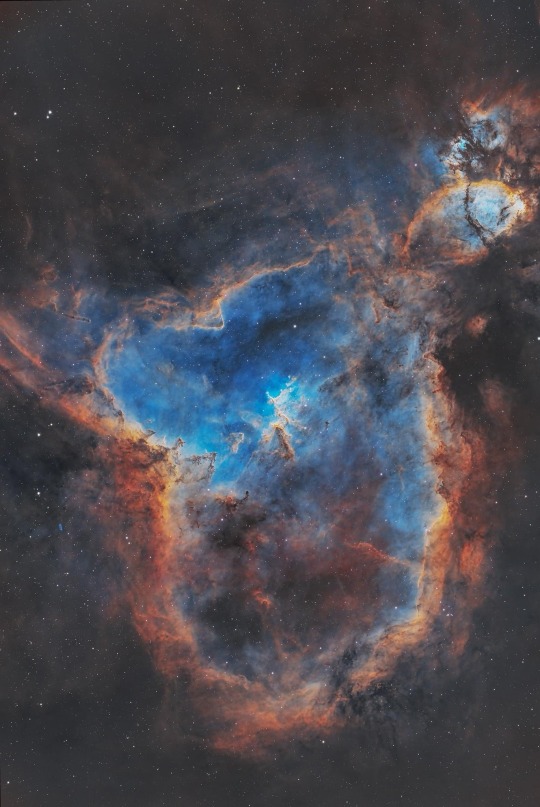
The Heart Nebula. This large emission nebula dubbed IC 1805 looks, in whole, like a human heart. This heart glows brightly in red light emitted by its most prominent element: hydrogen. The red glow and the larger shape are all created by a small group of stars near the nebula's center. In the heart of the Heart Nebula are young stars from the open star cluster Melotte 15 that are eroding away several picturesque dust pillars with their energetic light and winds. The open cluster of stars contains a few bright stars nearly 50 times the mass of our Sun, many dim stars only a fraction of the mass of our Sun, and an absent microquasar that was expelled millions of years ago. The Heart Nebula is located about 7,500 light years away toward the constellation of the mythological Queen of Aethiopia (Cassiopeia).
0 notes
Text

The star cluster Melotte 15 at the center of the Heart Nebula (IC 1805) // Grégory Fabre
#astronomy#astrophotography#stars#star cluster#open cluster#melotte 15#nebula#emission nebula#star-forming region#heart nebula#IC 1805#Sh2-190#cassiopeia
36 notes
·
View notes
Text
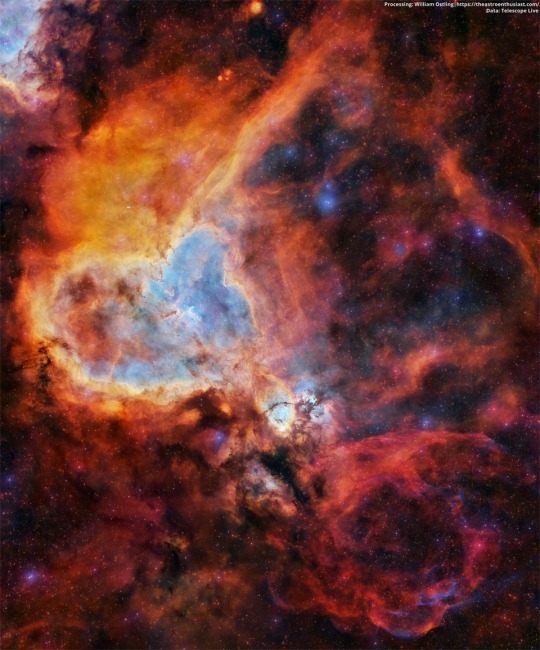
APOD December 13, 2023
Deep Field: The Heart Nebula
What excites the Heart Nebula? First, the large emission nebula on the left, catalogued as IC 1805, looks somewhat like a human heart. The nebula glows brightly in red light emitted by its most prominent element, hydrogen, but this long-exposure image was also blended with light emitted by silicon (yellow) and oxygen (blue). In the center of the Heart Nebula are young stars from the open star cluster Melotte 15 that are eroding away several picturesque dust pillars with their atom-exciting energetic light and winds. The Heart Nebula is located about 7,500 light years away toward the constellation of Cassiopeia. At the bottom right of the Heart Nebula is the companion Fishhead Nebula. This wide and deep image clearly shows, though, that glowing gas surrounds the Heart Nebula in all directions.
©
William Ostling,
Telescope Live
0 notes
Photo

Melotte 15 in the Heart
Credits: Ivan Eder
1 note
·
View note
Photo
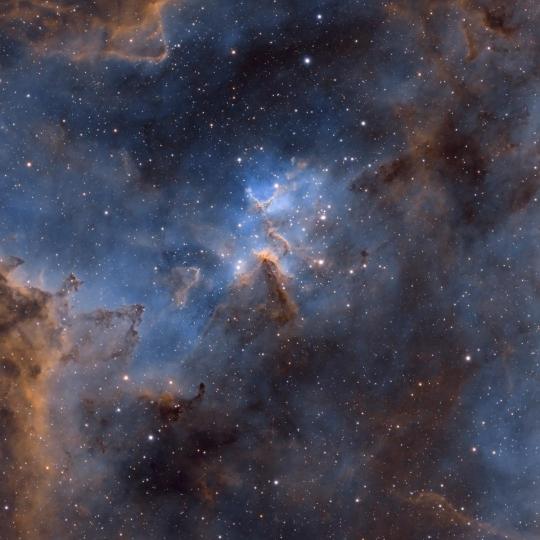
Astronomy Photographer of the Year 2022 - Best Newcomer
The Heart of the Heart – Melotte 15 by Hannah Rochford
0 notes
Photo
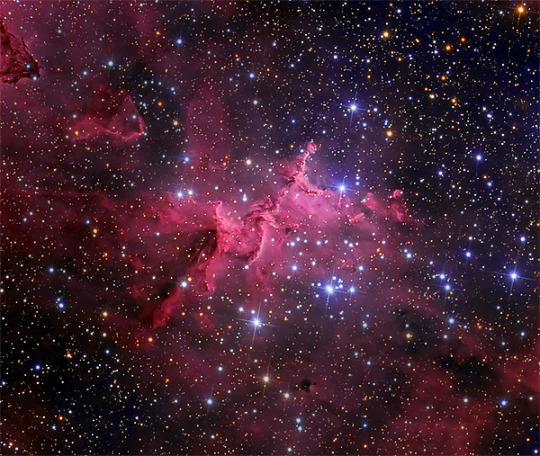
Open star cluster at the center of Cosmic Heart
#nasa#heart nebula#ic 1805#astronomy#astrophotography#galaxy#planet#cosmos#stars#night sky#universe#planets#solar system#nebula#space#melotte 15
1K notes
·
View notes
Photo

Another one from last week, the core of the Heart Nebula (IC 1805) in Ha+OIII with the star cluster, Melotte 15 surrounding coils and branches of interstellar dust and gas. Gear notes: I captured all the data in my backyard with an Apertura 800mm f/4 Newtonian OTA, ZWO ASI1600MM-Pro mono camera, Antlia 3nm filters, ZWO ASI290M OAG, on the Sky-Watcher EQ6R-Pro mount with the ZWO ASIAir Plus controller. More of my astro stuff: https://SaltwaterWitch.com
3 notes
·
View notes